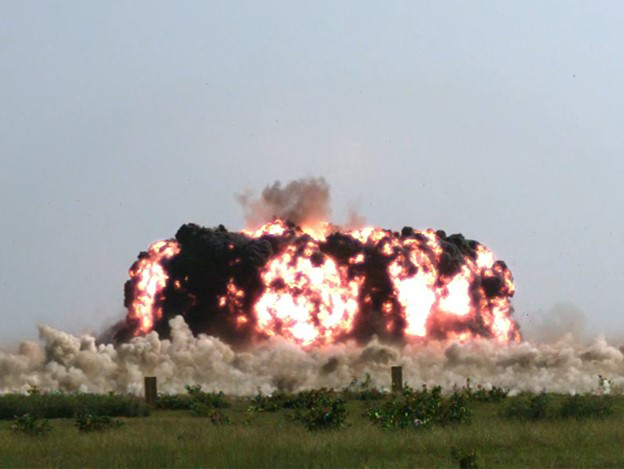AFRL showcases new precision effects capability
EGLIN AIR FORCE BASE, Fla. (AFRL) – The Air Force Research Laboratory concluded its Dialable Effects Munition demonstration program during a test of the experimental weapon July 28.
The DEM, an Office of the Secretary of Defense-funded Joint Capability Technology Demonstration, aims to mature, demonstrate and transition technologies that enable a weapon’s effects to be tailored dynamically in flight. This new capability will give the Department of the Air Force the ability to prosecute targets more effectively in high-end fights, which equates to greater mission flexibility.
During the mission, an F-16 from the 96th Test Wing released a single DEM onto the target area. Prior to the weapon’s release, the pilot programmed the DEM to conduct a precise lethal footprint attack from the cockpit. The precise lethal footprint attack focuses the weapons effects to a limited area where collateral damage could be a concern. Ultimately, the DEM achieved the mission as planned with evidence of its effectiveness visible throughout the target area.
An earlier successful mission demonstrated the DEM’s ability to conduct a wide area attack mission, which delivers effects across a large target area. Additionally, a sled test was conducted to confirm the weapon’s perforation capability in late 2020.
“The new innovative technologies developed from this effort will give our aircrews increased capability to control the desired effects of weapon systems,” said Gerald Tighe, Oversight Executive Deputy Director, JCTD Programs, at OSD. “Through the DEM JCTD’s proven cockpit selectable (Dialable) effects technology the warfighter will be able strategically carry out the mission more effectively.”
The DEM is a 2,000-pound munition containing a number of AFRL Munitions Directorate technologies as well as contributions from the Army Combat Capabilities Development Command and contractor partners including Faxon Machining and L3 Harris. DEM technologies include a pre-formed fragment warhead case, an electronic safe and arm device, distributed embedded firesets, and a precision height-of-burst sensor. These technologies control the weapon’s lethal footprint, fragment speed and direction, while a Joint Direct Attack Munition tail kit guides the munition to the target.
In effect, the pilot can select munition effects based on three critical mission areas: An Area Attack effect that detonates high above the target for maximum dispersed effects over the area where collateral damage is not an issue; A Precise Lethal Footprint effect that detonates lower over the target to confine effects to a small area for low-collateral damage; and a Surface Target Perforation effect that detonates after the weapon punches through a structure.
The success of the DEM’s first live flight test was bolstered by AFRL’s partnership with OSD and United States Central Command.
Although DEM continues testing, its fuzing, explosives, warhead, and sensors have transitioned to several weapons programs, where they are already increasing effectiveness and survivability.
While the technology is useful in weapons of many sizes, a large form factor will give the Department of the Air Force a unitary weapon that performs as well or better than current cluster munitions; albeit, without the concerns of unexploded ordnance or UXO.
With the success of this test, aircrews will be able to modify munitions effects to accommodate dynamic target tasking in-flight, enabling a capability that greatly influences the success of pilots and aircrews in diverse and dynamic battlefields. Additionally, having a weapon that can fill the role of three or more different weapons streamlines the logistics footprint, which has positive implications for costs, storage and time.
“I’m really excited to see the team tackling tough problems like dialable effects, so our warfighters have options for weapons that respond to their needs, as conditions change in the heat of battle,” said Maj. Gen. Heather Pringle, AFRL commander. “In addition, the technology has the potential to simplify the sizes and types of weapons needed at the forward edge of the battlefield, which leads to a more efficient, less costly support tail.”
Future work will focus on continuing the transition of technologies from DEM to current weapon programs and miniaturizing the technology to increase weapon load out and aircraft platform availability.
“We must ensure our weapon systems can adapt to changing operational conditions faster than our adversary can react,” said Joe Letsinger, Senior Scientific Technical Manager at AFRL’s Munitions Directorate. “The technologies we are pursuing for DEM, specifically for adaptive warheads, gives us the ability to effectively prosecute a wider range of targets from a single weapon. Ultimately, this technology will enable future systems to dynamically assign targets based on real-time information during a mission.”

The Dialable Effects Munition delivers a precision effect to a target during a demonstration of the weapon’s capabilities on July 28, 2021. (Courtesy photo)
